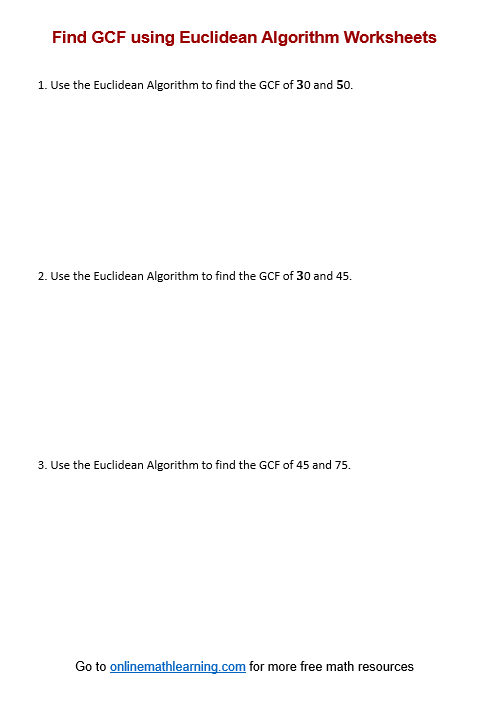GCF using Euclidean Algorithm Worksheet
Related Topics:
More Grade 6 Math Lessons
Free Math Worksheets
Free Printable Worksheets
Related Printable Worksheets:
Prime & Composite Numbers
Reduce Proper Fractions
Simplify Proper & Improper Fractions
Divisibility Tests to find Factors
GCF using Euclidean Algorithm
Free printable and online worksheets to help Grade 6 students learn how to use the Euclidean Algorithm to find the GCF or the GCD.
How to use the Euclidean Algorithm to find the GCF?
The Euclidean Algorithm is an efficient method for finding the Greatest Common Factor (GCF) of two whole numbers.
Here’s how it works:
- Divide the larger of the two numbers by the smaller one.
- If there is a remainder, divide it into the divisor.
- Continue dividing the last divisor by the last remainder until the remainder is zero.
- The final divisor is the GCF of the original pair of numbers.
In application, the algorithm can be used to find the side length of the largest square that can be used to completely fill a rectangle without overlap or gaps.
Have a look at this video if you need to review how to use the Euclidean Algorithm to find the GCF or GCD.
Click on the following worksheet to get a printable pdf document.
Scroll down the page for more GCF using Euclidean Algorithm Worksheets.
More GCF using Euclidean Algorithm Worksheets
Printable
(Answers on the second page.)
GCF using Euclidean Algorithm Worksheet #1
GCF using Euclidean Algorithm Worksheet #2
GCF using Euclidean Algorithm Worksheet #3
Related Lessons & Worksheets
Try out our new and fun Fraction Concoction Game.
Add and subtract fractions to make exciting fraction concoctions following a recipe. There are four levels of difficulty: Easy, medium, hard and insane. Practice the basics of fraction addition and subtraction or challenge yourself with the insane level.

We welcome your feedback, comments and questions about this site or page. Please submit your feedback or enquiries via our Feedback page.
